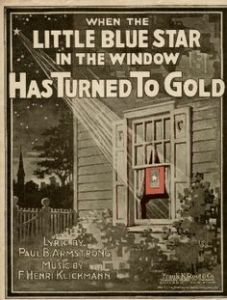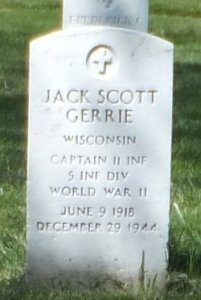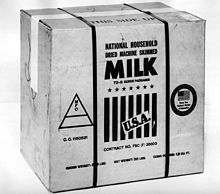When it came time to take my kitchen cleaning back to WWII the list of cleaning supplies was pretty short. Household cleaning, especially during WWII, came down to some simple staples: vinegar, baking soda, salt, ammonia, bleach, Watkins supplies, Borax and Coca-Cola. I had a picture in my mind that my grandmothers would have been using products we refer to as “green cleaning” today – natural and safe enough to put in food recipes also, but that wasn’t always the case.
Under the heading of “When You Know Better You Do Better”, came the emerging chemistry of cleaning supplies. Harsh cleaning chemicals were in demand as the country rebounded from The Great Depression and considered hospital-grade sanitation necessary at home.
Housewives were hearing the scientific name of the cleanser, as opposed to our “dumbed-down” advertised names today (carbon tetrachloride, anyone?). Advertisements went to great lengths to intelligently reason with the consumer and share the logic of buying the product.
Watkins, known for medicinal salves and spices, devoted 90% of its production capacity to support the Allied war effort. To fill government contracts, Watkins produced dried egg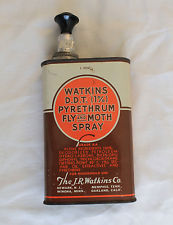 s, powdered juice packets, vitamin tablets, hospital germicide, DDT and insecticide powder.
s, powdered juice packets, vitamin tablets, hospital germicide, DDT and insecticide powder.
Home use of DDT was popular. My Grandmother was a new bride in 1946, stationed with my Grandfather on a US Army base in Kentucky. They were enjoying a blissful, newlymarried life living in a tiny travel trailer. (When I say “tiny”, I mean really, really tiny.) Grandma wrote letters home in a constant stream and her adventures of living in the trailer are fun to read:
“I’ve got my dishes done and my house all cleaned up. Roy came home at 3:30 and had to be back by 4:30. He has to drive “his” jeep all night tonight and also tomorrow night. I was just going to do dishes when our next door neighbor poked her head out the window and said, “Honey, do you want to bake something in my oven?” So, honey said yes and I made a pumpkin pie, but not that easy. The recipe asked for ginger. So I went next door and asked for some, no luck; she said try next door, so I went there and she had some. Of course, they both asked me to sit down to stay a while so I’m getting to be just another old hen. Well, I got almost done and ready for the eggs. Boy, were they rotten!! Can you smell them up there? So I hiked over to the neighbors and asked her for two eggs, stayed awhile and came home again. I just about got all done and I spotted where the ants were running. Just opposite the door under that window casing, so I ripped off a strip of board and some off the wall and got out the sprayer and DDT. Boy did they catch —. Big funeral tomorrow, my ants died. Now I won’t have anything to do! Ha! Ha! I got the pie done for dinner and was it ever swell! I made another curtain today, the one for the back window. The neighbor lady asked me to come over to bring my sewing and keep her company.”
From the same letters, I came to understand the enormous chore of laundry. Most cleaning product advertising from the time was devoted to the task. Suds were really important when it came to proving clean.
Rinso was the brand name of a laundry soap most commonly used in the United States and dated back to 1908. From 1936-1950 it was the first mass-marketed soap powder. It was advertised widely on radio, being the sponsor of many network programs such as the popular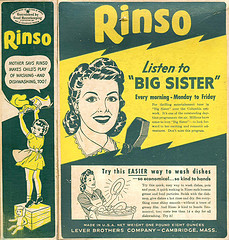 daytime soap opera Big Sister from 1936 to 1946, and the night-time programs Big Town from 1937 to 1942, and The Amos ‘n’ Andy Show from 1943 to 1950. During this time the product’s advertisements happily chanted the slogan “Rinso white, Rinso bright” and boasted that Rinso contained “Solium, the sunlight ingredient”. Post-WWII, Rinso lost its market to Tide and tried to rebrand in the 1960’s, but disappeared from store shelves by the mid-1970s. Unilever, its manufacturer, replaced the name with Surf in the US (Rinso survives in Turkish, Asian, and Central American markets). But, don’t count a good thing out – in 1992, the 99 Cents Only Store brand purchased the rights to the name “Rinso” from Unilver for use in the US and Rinso brand cleaning supplies are now prominently displayed in their stores. http://www.gracesguide.co.uk/Rinso
daytime soap opera Big Sister from 1936 to 1946, and the night-time programs Big Town from 1937 to 1942, and The Amos ‘n’ Andy Show from 1943 to 1950. During this time the product’s advertisements happily chanted the slogan “Rinso white, Rinso bright” and boasted that Rinso contained “Solium, the sunlight ingredient”. Post-WWII, Rinso lost its market to Tide and tried to rebrand in the 1960’s, but disappeared from store shelves by the mid-1970s. Unilever, its manufacturer, replaced the name with Surf in the US (Rinso survives in Turkish, Asian, and Central American markets). But, don’t count a good thing out – in 1992, the 99 Cents Only Store brand purchased the rights to the name “Rinso” from Unilver for use in the US and Rinso brand cleaning supplies are now prominently displayed in their stores. http://www.gracesguide.co.uk/Rinso
I absolutely love the Rinso commercials played in movie theaters from the time:
http://aso.gov.au/titles/ads/rinso-easy-does-it/clip1/
http://aso.gov.au/titles/ads/rinso-soap-happiness/clip1/
Another letter entry from my Grandmother, “I got up at 6:30 this morning and did the washing. Gee what a wash! It wouldn’t be anything with a machine but oh this by hand stuff. I washed two sheets, about six bath towels, two pair Army pants, shirt, 2 tablecloths, 4 dish towels, that heavy red rug, and all our clothes besides. It took me about four hours.”
Change to DUZ for ALL 3 KINDS of War-time Wash!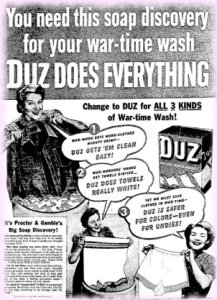
It’s Procter & Gamble’s Big Soap Discovery!
Got some work-clothes or play-clothes in your wartime wash? And less time than ever to do them? You need a new kind of soap to speed you through! You need DUZ!
War-time washes are extra dirty, too! Men folk on the production line . . . dirt from Victory gardens — from factory chimneys — it all adds up to trouble for you. Yes, you want a new kind of soap to do the job today — a soap that gets dirty towels really white and cleans grimy overalls easy. That’s DUZ. . . YOUR SOAP FOR EVERYTHING.
Yet In war-time— your clothes must last and last. Remember — you can trust even bright washable prints and pretty rayon undies to those fluffy DUZ suds! Yes— this amazing new kind of soap gets clothes as white as any soap made, yet it’s safer than any of the other 4 leading granulated soaps — definitely safer for colors, for your hands.
No cloud of “sneezy dust”. In DUZ— it’s amazingly sneeze-free. Be thrifty — buy the Giant size. One big red box does everything in an average wash for weeks! September 16, 1942
(Found at : http://www.retro-housewife.com/1940-housekeeping.html )
Here is a rundown of the steps to clean laundry during the WWII era:
Soak: Soak cotton and linen articles in lukewarm soapy water, or in cold water with 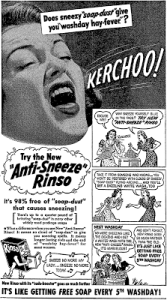 borax, 2 tablespoons to the gallon. Soak handkerchiefs separately. Do not soak colored or wool articles.
borax, 2 tablespoons to the gallon. Soak handkerchiefs separately. Do not soak colored or wool articles.
Wash: Wring out the clothes from the soaking water. Wash with plenty of hot soapy water made with shredded washing soap, soap flakes or jelly. Use two lots if necessary. Rub dirty clothes gently on a wash board with your hand or a nail brush. Do not rub silks, rayons, and wool. Use only mild soap for them, and do not put them in very hot water.
Rinse: Soften hard rinsing water with borax. Repeat warm rinses till the water is clear, and add a little glue to the last water for white cottons and linens.
Dry: Dry outdoors when possible, but do not put silks and wool in the sun or too near the fire. Hang white cottons and linens in the sun to bleach. Dry colored articles in the shade, inside out.
Starch: The heavier and wetter the material, the more starch you need, and if you wring with a wringer you need thicker starch than if you work by hand. Starch articles inside out, using hot starch for white things and cold tinted starch for colored ones. Use blue to tint blue, cochineal for pink, coffee or tea for brown, and a vegetable dye for green. To mix starch, make a smooth paste with starch and cold water, using a wooden spoon, then add boiling water until the starch is clear.
Mangle: Leave clothes until quite dry, then sprinkle them evenly. Fold and roll up, and leave them for an hour before mangling or ironing. Pull garments into shape and put them evenly between the rollers, protecting any buttons.
Iron: The iron should be hot enough to splutter when touched with a wet finger, and you should iron as quickly as possible, continuing till the material is dry. To iron a garment, first go over all parts that hang off the board, then iron the center. To bring out a pattern or monogram, iron on the wrong side over a thick pad. Have a very hot iron for starched articles and a moderate one for silks and wool. Press damp knitted goods between flour sack towels.
Air: If you have no heated linen cupboard, hang straight, folded articles on a clothes rack, and garments with sleeves on hangers to air in the sun or near the fire. Source: Craig, Elizabeth. 1000 Household Hints. London
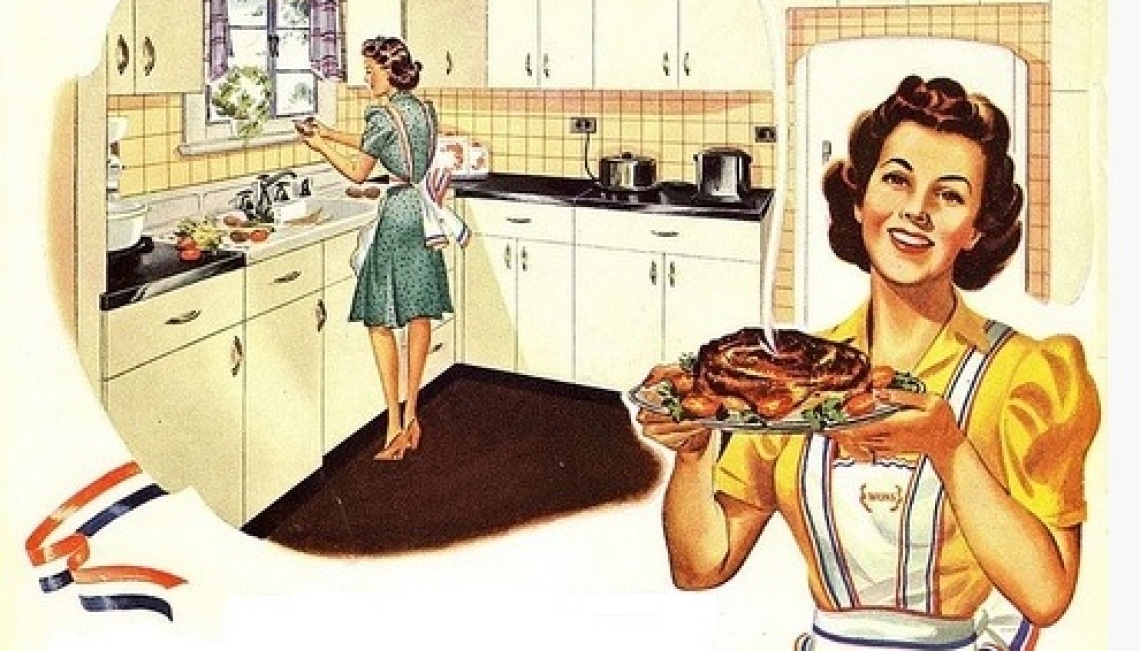

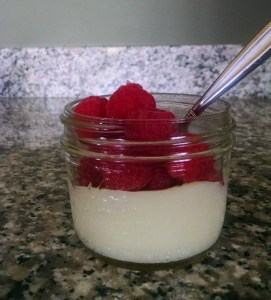
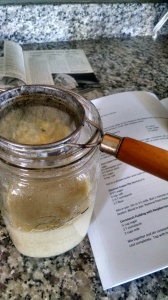
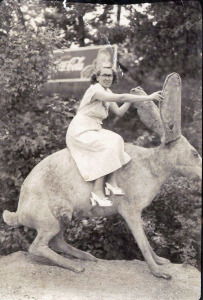
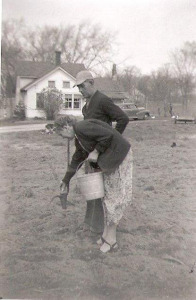
![IMG_20150405_210119642[1]](https://www.thewarinmykitchen.com/wp-content/uploads/2015/04/IMG_20150405_2101196421-300x168.jpg)
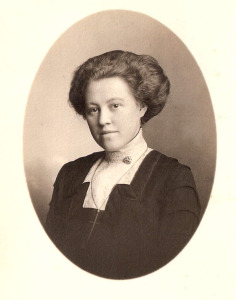

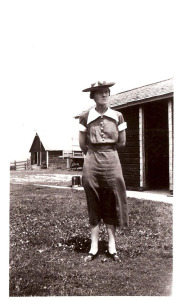
![IMG_20150330_181404770[1]](https://www.thewarinmykitchen.com/wp-content/uploads/2015/03/IMG_20150330_1814047701-300x168.jpg)
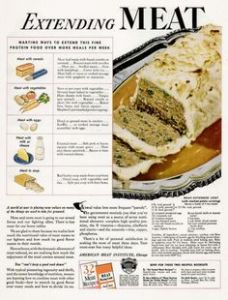 pamphlets, The American Meat Institute introduced a new, creative, and meat-extending version of meatloaf in 1943. Frosted Meatloaf. It was a regular meatloaf with mashed potatoes “frosting”.
pamphlets, The American Meat Institute introduced a new, creative, and meat-extending version of meatloaf in 1943. Frosted Meatloaf. It was a regular meatloaf with mashed potatoes “frosting”.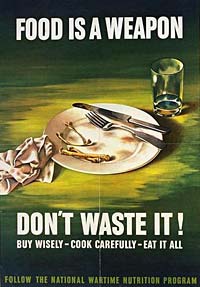
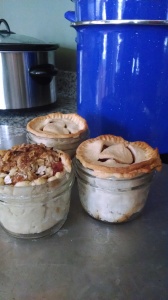
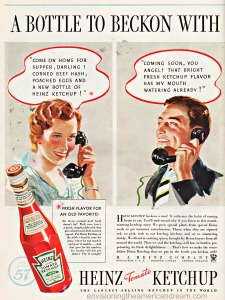
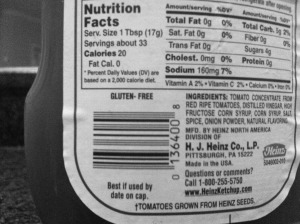
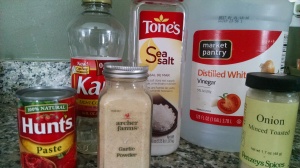
![IMG_20150215_162036063[1]](https://www.thewarinmykitchen.com/wp-content/uploads/2015/02/IMG_20150215_1620360631-300x168.jpg)
